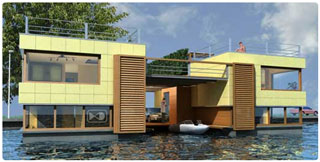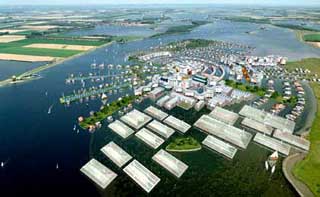The Dutch are gearing up for climate change with amphibious houses. If rivers rise above their banks, the houses rise upwards as well.
 Drive-in from Waterstudio.
Drive-in from Waterstudio.
37 “swimming” houses are already strung along a branch of the Maas. At first glance, they seem quite unremarkable. The cellar, in this case, is not built into the earth, but on a platform. The hollow foundation of each house works in the same way as the hull of a ship, buoying the structure up above water. To prevent the houses from floating away, they slide up two steel posts – and as the water level sinks, so they sink back down again.
“The columns have been driven deep into solid ground,” explains Dick van Gooswilligen from the construction company. “They are even strong enough to withstand currents you would find on the open seas. As global warming causes the sea level to rise, this is the solution.”

One of the leading architects in maritime architecture is Koen Olthuis. His office has designed houseboats with a parking deck for the car and lower deck storage for a motorboat. Now, his team is coming up with plans for office buildings a hundred meters in height that “swim.” The key is a technique whereby the foundation of the construction can be transformed into a float. A foam core is encased in concrete, with steel cables securing it against the pull of potential currents. Individual pontoons can be joined to one another like Lego blocks.
“This construction model is built to last at least one hundred years,” Olthuis says. If anything should happen to the foundation, the whole thing can be taken to the dockyard.
The first town based on this model, numbering 12,000 houses, might conceivably be built close to Amsterdam’s Schiphol airport.
Via Archinect Der Spiegel.







